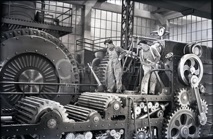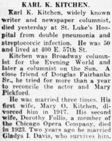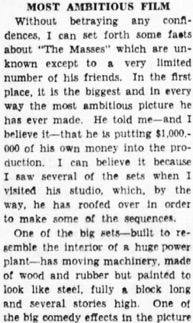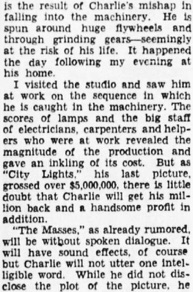Modern Times 1935 1936 1937 next previous
Modern Times Clippings 136/382
Karl K. Kitchen, Los Angeles Times, L. A., Cal., March 17, 1935.
Modern Times Set
& Chaplin Names Picture
Hollywood, March 28. – Charles Chaplin has selected
„The Masses“ as the title of his present picture now in work under
the name of „Production No. 5.“
(...) Motion Picture Daily, New York, March 29, 1935.
& The late Karl K. Kitchen
(...) Photo, Daily News, New York, June 25, 1935
& KARL K. KITCHEN
Karl K. Kitchen, widely known writer and newspaper
columnist, died yesterday at St. Luke‘s Hospital
from double pneumonia and streptococcic infection. He was 50
and lived at 400 E. 57th St.
Kitchen was Broadway columnist for the Evening World
and later a columnist on the Sun. A close friend of
Douglas Fairbanks Sr., he tried for more than a year to reconcile
the actor and Mary Pickford.
He was married three times. His first wife, Mary O. Kitchen,
divorced him in 1917. His second wife, Dorothy Follis,
a member of the Chicago Opera Company, died in 1923. Two
years ago he married Gladys I. Davis, who survives him.
(...) Daily News, New York, June 22, 1935
„A humble worker in a high-pressure factory“
Editorial content. „Chaplin Tells Theme
of His New Picture
„The Masses“ Will Be Satire on Industry;
Without Dialogue
BY KARL K. KITCHEN
I had been invited to dine at the Chaplin home at 8 o‘clock,
but, although I did not arrive until quarter past, my host
had not returned from his studio. Miss Paulette Goddard, his
leading lady in his new picture, and, unless I am
terribly mistaken, his leading lady in his private life, received
me in the library, where we chatted over cocktails
until he arrived, perhaps half an hour later. At any rate, it was
nearly 9 o‘clock before we sat down for dinner.
Naturally, I wanted to hear about his new picture – Production
No. 5, as it has been called up to date. And, with some
reluctance, Charlie told me something about it. For instance,
he has definitely decided to call it The Masses. But,
although it has been in production more than five months, it is
still uncompleted. Even if it is finished this spring,
it will not be shown until next fall – when he will come to New
York, take a theater on Broadway and offer it to the
palpitating public – his first picture in four and a half years.
MOST AMBITIOUS FILM
Without betraying any confidences, I can set forth some
facts about The Masses which are unknown except
to a very limited number of friends. In the first place, it is the
biggest and in every way the most ambitious picture
he has ever made. He told me – and I believe it – that he is
putting $1,000,000 of his own money into the production.
I can believe it because I saw several of the sets when I visited
his studio, which, by the way, he has roofed over in order
to make some of the sequences.
One of the big sets – built to resemble the interior of a huge
power plant – has moving machinery, made of wood
and rubber but painted to look like steel, fully a block long
and several stories high. One of the big comedy
effects in the picture is the result of Charlie‘s mishap in falling
into the machinery. He is spun around huge flywheels
and through grinding gears – seemingly at the risk of his life.
It happened the day following my evening at his home.
I visited the studio and saw him at work on the sequence
in which he is caught in the machinery. The scores
of lamps and the big staff of electricians, carpenters and
helpers who were at work revealed the magnitude
of the production and gave an inkling of its cost. But as City
Lights, his last picture, grossed over $5,000,000,
there is little doubt that Charlie will get his million back
and a handsome profit in addition.
The Masses, as already rumored, will be without spoken
dialogue. It will have sound effects, of course, but
Charlie will not utter one intelligible word. While he did not
disclose the plot of the picture, he told me enough
about it to give me an idea of its theme, which deals with
a humble worker in a high-pressure factory. The cog
in the machine, played, of course, by Charlie, is obliged to work
at such speed that he does not even have time
to scratch – so rapidly has he to place nuts on the machines
which move by on conveyors. When he does
finally drop a nut, in order to scratch himself, his action
upsets the entire factory. he is discharged, and,
on his way home, steals a ride on a repair wagon, only
to fall off with a red flag in his hand. Running
after the repair truck to replace the warning signal,
he is followed by a parade of Communists,
who mistake him for their leader. He runs into a policeman,
who, of course, raps him over the head, and
Charlie awakes in a jail, only to have other adventures
before the final rally.“ (...)
The definite title of Chaplin‘s film will be „Modern Times.“
Karl K. Kitchen, Chaplin and „The Masses,“
New York Times, March 17, 1935
(New York Times Co. and North American Newspaper
Alliance, Inc., New York).
Redaktioneller Inhalt
Modern Times 1935 1936 1937 next previous







